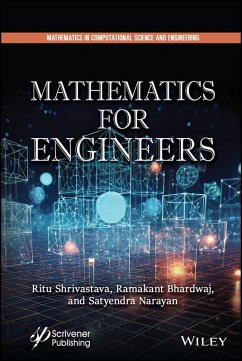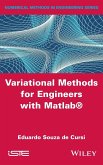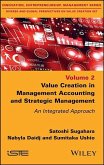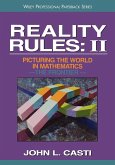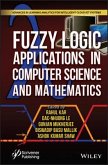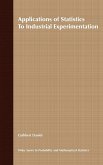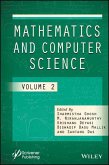- Gebundenes Buch
- Merkliste
- Auf die Merkliste
- Bewerten Bewerten
- Teilen
- Produkt teilen
- Produkterinnerung
- Produkterinnerung
Mathematics for Engineers serves as a comprehensive guide on the basics of mathematics and their applications in engineering for students and seasoned professionals alike. Mathematics for Engineers is designed to help students develop mathematical proficiencies, which are required in technical courses and careers involving strategic mathematical competence and adaptive reasoning. This volume also acts as a reference for professionals in engineering who need a refresher for their technical math skills. Through this book, students and professionals in the engineering discipline will build a…mehr
Andere Kunden interessierten sich auch für
![Variational Methods for Engineers with MATLAB Variational Methods for Engineers with MATLAB]() Eduardo Souza De CursiVariational Methods for Engineers with MATLAB159,99 €
Eduardo Souza De CursiVariational Methods for Engineers with MATLAB159,99 €![Value Creation in Management Accounting and Strategic Management Value Creation in Management Accounting and Strategic Management]() Satoshi SugaharaValue Creation in Management Accounting and Strategic Management159,99 €
Satoshi SugaharaValue Creation in Management Accounting and Strategic Management159,99 €![Reality Rules, the Frontier Reality Rules, the Frontier]() John CastiReality Rules, the Frontier147,99 €
John CastiReality Rules, the Frontier147,99 €![Fuzzy Logic Applications in Computer Science and Mathematics Fuzzy Logic Applications in Computer Science and Mathematics]() ShawFuzzy Logic Applications in Computer Science and Mathematics174,99 €
ShawFuzzy Logic Applications in Computer Science and Mathematics174,99 €![Applications of Statistics to Industrial Experimentation Applications of Statistics to Industrial Experimentation]() Cuthbert DanielApplications of Statistics to Industrial Experimentation294,99 €
Cuthbert DanielApplications of Statistics to Industrial Experimentation294,99 €![Mathematics and Computer Science, Volume 2 Mathematics and Computer Science, Volume 2]() GhoshMathematics and Computer Science, Volume 2198,99 €
GhoshMathematics and Computer Science, Volume 2198,99 €![Markov Chains Markov Chains]() Bruno SericolaMarkov Chains159,99 €
Bruno SericolaMarkov Chains159,99 €-
-
-
Mathematics for Engineers serves as a comprehensive guide on the basics of mathematics and their applications in engineering for students and seasoned professionals alike. Mathematics for Engineers is designed to help students develop mathematical proficiencies, which are required in technical courses and careers involving strategic mathematical competence and adaptive reasoning. This volume also acts as a reference for professionals in engineering who need a refresher for their technical math skills. Through this book, students and professionals in the engineering discipline will build a capacity and expand their fundamental mathematical skills for logical thought, reflection, explanation, and justification in the field of applied science. This book is designed for general use for science and engineering students across the globe. The book effectively compiles important information in one place alongside examples and practice problems with application and practice based questions. Emphasis is placed on the application of mathematics in appropriate context and modeling of real-world situations. By the end of this book, students and professionals in the engineering discipline will be able to present and process their mathematical reasoning and conclusions numerically, graphically, symbolically, and verbally.
Produktdetails
- Produktdetails
- Verlag: Wiley
- Seitenzahl: 576
- Erscheinungstermin: 13. Mai 2025
- Englisch
- Abmessung: 250mm x 150mm x 15mm
- Gewicht: 907g
- ISBN-13: 9781394214587
- ISBN-10: 1394214588
- Artikelnr.: 69974387
- Herstellerkennzeichnung
- Libri GmbH
- Europaallee 1
- 36244 Bad Hersfeld
- gpsr@libri.de
- Verlag: Wiley
- Seitenzahl: 576
- Erscheinungstermin: 13. Mai 2025
- Englisch
- Abmessung: 250mm x 150mm x 15mm
- Gewicht: 907g
- ISBN-13: 9781394214587
- ISBN-10: 1394214588
- Artikelnr.: 69974387
- Herstellerkennzeichnung
- Libri GmbH
- Europaallee 1
- 36244 Bad Hersfeld
- gpsr@libri.de
Ritu Shrivastava, PhD, is an assistant professor in the Mathematics Department at Bahrain Polytechnic, India with over 20 years of teaching experience. She has published ten articles in national and international journals and conferences of repute. Her teaching interests include applied mathematics, calculus, algebra, coordinate geometry, trigonometry, and probability. Ramakant Bhardwaj, PhD, is professor in the Mathematics Department at the Amity Institute of Applied Sciences, Kolkata, India with over 17 years of teaching experience. He has over 200 publications in national and international journals of repute. His research interest include nonlinear analysis, mathematical modeling, phase transition study, and computer oriented mathematics. Satyendra Narayan, PhD, is a professor in the Applied Science and Technology Department at Sheridan College, Canada with over 25 years of research experience. He has published over 30 articles and worked on a projects with a number of institutions, including the United Nations Development Programme. His research interests include applied computing, geosciences, and electrical monitoring of subsurface processes.
Preface xi
1 Fractions, Decimals, and Percentages 1
1.1 Introduction 1
1.2 Fractions 2
1.2.1 Definition of Fractions 2
1.2.2 Types of Fractions 2
1.2.3 Simplest Form or Fraction in Lowest Term 6
1.2.4 Comparing Fractions 7
1.2.5 Algebra of Fractions 8
1.3 Decimals and Percentages 25
1.4 Check Your Knowledge (MCQ) 31
1.5 Activity/Experiment 34
2 Ratio and Proportion 37
2.1 Introduction 37
2.2 Ratios 38
2.2.1 Definition 38
2.2.2 Simplifying Ratio 38
2.2.3 Equivalent Ratio 38
2.2.4 Methods for Finding a Ratio 39
2.2.5 Methods to Calculate Increasing and Decreasing in Each Ratio 40
2.3 Rate 45
2.3.1 Unit Rates 46
2.4 Proportions 46
2.4.1 Direct Proportion 47
2.4.2 Inverse Proportion 49
2.5 Activity/Experiment-Ratio 55
2.6 Activity/Experiment-Proportions 57
3 Two-Dimensional Geometry 59
3.1 Introduction 59
3.2 Geometry 60
3.2.1 One-Dimensional Geometry 60
3.2.2 Two-Dimensional Geometry 60
3.3 Area and Perimeter of 2D Shapes 60
3.3.1 Perimeter 61
3.3.2 Area of Two-Dimensional Geometry 69
3.3.3 Finding the Area of Shapes by Counting the Square 69
3.4 Curved Plane Figures 82
3.4.1 Circles 82
3.4.2 Semi-Circles 84
3.4.3 Quarter Circles (QUADRANT) 84
3.5 Perimeter and Area of Irregular Polygons and Composite Shapes 88
3.6 Check Your Knowledge (MCQ) 116
3.7 Activity/Experiment 118
4 Three-Dimensional Geometry 121
4.1 Introduction 121
4.2 Nets of Three-Dimensional Shapes 122
4.3 Surface Area and Volume of Three-Dimensional Shapes 124
4.3.1 A Cube 130
4.3.2 A Cuboid 133
4.3.3 Cylinder 141
4.3.4 Cone 145
4.3.5 Sphere 150
4.3.6 Hemisphere 151
4.3.7 Prism 153
4.3.8 Pyramid 155
4.4 Compounded Shapes 156
4.5 Check Your Knowledge (MCQ) 165
4.6 PBL/Experiment 169
5 Algebra and Graphs 171
5.1 Introduction 171
5.1.1 Early History of Algebra 172
5.1.2 Modern History of Algebra 172
5.1.3 Algebra 172
5.1.4 Algebra: What Is It? 173
5.1.5 Why Should We Study Algebra? 173
5.2 Algebraic Expressions 173
5.2.1 How are Expressions Formed? 173
5.2.2 Arithmetic Operators 174
5.3 Transposition of Formulae 177
5.4 Algebraic Fractions 181
5.4.1 How Can We Calculate Two Algebraic Fractions? 181
5.5 Simple Linear Equation 187
5.5.1 Formation of Algebraic Equation 187
5.5.2 How to Solve Linear Algebraic Equations? 188
5.6 Quadratic Equations 193
5.6.1 Solving Quadratic Equation 193
5.7 Simultaneous Equations 200
5.8 Graphs of Algebraic Functions 229
5.8.1 Graph of Linear Equations 229
5.8.2 Quadratic Equations Graphs 234
5.8.3 Simultaneous Equations 240
5.9 Exponential Functions 242
5.10 Check Your Knowledge (MCQ) 245
5.11 Activity/Experiment 247
6 Exponent and Logarithm 249
6.1 Introduction 249
6.2 Indices 250
6.2.1 Definition: Indices-[Concept: Repeated Multiplication] 250
6.2.2 Rules of Indices 251
6.3 Logarithms 256
6.3.1 Definition 256
6.3.2 Types of Logarithms [Depending on Base] 257
6.3.3 Rules of Logarithm 258
6.3.4 Characteristics and Mantissa of Logarithms 259
6.3.5 Properties of Logarithms 260
6.4 Check Your Knowledge (MCQ) 263
7 Trigonometry 267
7.1 Introduction 268
7.2 Pythagoras Theorem 268
7.3 Trigonometric Ratio 272
7.4 Trigonometry Table 274
7.4.1 Angles 275
7.5 The Angle of Elevation and Angle of Depression 284
7.5.1 Definition 284
7.6 Trigonometric Equation 288
7.6.1 Definition 288
7.6.2 Oriented Angle 288
7.6.3 Identities 289
7.6.4 Quadrants 291
7.7 Radian Measure 297
7.7.1 Converting Between Radians and Degrees 299
7.7.2 Area of Sector 301
7.8 The Sine and Cosine Rules 307
7.8.1 The Sine Rule 307
7.8.2 The Cosine Rule 308
7.8.3 Ambiguous Case 309
7.9 Steps to Use Calculator for Trigonometry 319
7.10 Check Your Knowledge (MCQ) 321
8 Differential Calculus 325
8.1 Introduction 325
8.2 Functions 327
8.2.1 Types of Functions 327
8.3 Limit and Continuity 328
8.3.1 Definition 328
8.3.2 One-Sided Limits 329
8.3.3 Continuity 329
8.4 Derivatives 330
8.4.1 Definition 330
8.4.2 List of Formulae 330
8.5 Differentiation Rules 331
8.6 Derivatives of Logarithmic and Exponential Function 344
8.6.1 Laws of Exponents 344
8.6.2 Rules of Logarithm 344
8.6.3 Rules for Finding the Derivative of Log and Exp 344
8.7 Derivatives of Trigonometric Function 351
8.8 Application of Derivatives 357
8.9 Maxima and Minima 358
8.10 Check Your Knowledge (MCQ) 368
8.11 Activity/Experiment 369
9 Integral Calculus 371
9.1 Introduction 371
9.2 Integration Rules 372
9.3 Integration by Parts 382
9.4 Integration by Partial Fraction 386
9.5 Definite Integral 387
9.6 Check Your Knowledge (MCQ) 430
10 Probability 435
10.1 Introduction 435
10.2 Fundamental Principle of Counting 438
10.3 Permutations and Combinations 441
10.3.1 Permutation 442
10.3.2 Combinations 444
10.4 Simple Probability 446
10.4.1 Probability of an Event 448
10.4.2 Equally Likely Events 448
10.5 Conditional Probability 450
10.6 Probability Sample Space Diagram 454
10.7 Probability Tree Diagram 456
10.8 Probability Using Venn Diagram 458
10.8 Check Your Knowledge (MCQ) 466
10.9 PBL/Experiment (Experimental Probability Vs. Theoretical Probability)
469
Answers 471
About the Authors 539
Index 541
1 Fractions, Decimals, and Percentages 1
1.1 Introduction 1
1.2 Fractions 2
1.2.1 Definition of Fractions 2
1.2.2 Types of Fractions 2
1.2.3 Simplest Form or Fraction in Lowest Term 6
1.2.4 Comparing Fractions 7
1.2.5 Algebra of Fractions 8
1.3 Decimals and Percentages 25
1.4 Check Your Knowledge (MCQ) 31
1.5 Activity/Experiment 34
2 Ratio and Proportion 37
2.1 Introduction 37
2.2 Ratios 38
2.2.1 Definition 38
2.2.2 Simplifying Ratio 38
2.2.3 Equivalent Ratio 38
2.2.4 Methods for Finding a Ratio 39
2.2.5 Methods to Calculate Increasing and Decreasing in Each Ratio 40
2.3 Rate 45
2.3.1 Unit Rates 46
2.4 Proportions 46
2.4.1 Direct Proportion 47
2.4.2 Inverse Proportion 49
2.5 Activity/Experiment-Ratio 55
2.6 Activity/Experiment-Proportions 57
3 Two-Dimensional Geometry 59
3.1 Introduction 59
3.2 Geometry 60
3.2.1 One-Dimensional Geometry 60
3.2.2 Two-Dimensional Geometry 60
3.3 Area and Perimeter of 2D Shapes 60
3.3.1 Perimeter 61
3.3.2 Area of Two-Dimensional Geometry 69
3.3.3 Finding the Area of Shapes by Counting the Square 69
3.4 Curved Plane Figures 82
3.4.1 Circles 82
3.4.2 Semi-Circles 84
3.4.3 Quarter Circles (QUADRANT) 84
3.5 Perimeter and Area of Irregular Polygons and Composite Shapes 88
3.6 Check Your Knowledge (MCQ) 116
3.7 Activity/Experiment 118
4 Three-Dimensional Geometry 121
4.1 Introduction 121
4.2 Nets of Three-Dimensional Shapes 122
4.3 Surface Area and Volume of Three-Dimensional Shapes 124
4.3.1 A Cube 130
4.3.2 A Cuboid 133
4.3.3 Cylinder 141
4.3.4 Cone 145
4.3.5 Sphere 150
4.3.6 Hemisphere 151
4.3.7 Prism 153
4.3.8 Pyramid 155
4.4 Compounded Shapes 156
4.5 Check Your Knowledge (MCQ) 165
4.6 PBL/Experiment 169
5 Algebra and Graphs 171
5.1 Introduction 171
5.1.1 Early History of Algebra 172
5.1.2 Modern History of Algebra 172
5.1.3 Algebra 172
5.1.4 Algebra: What Is It? 173
5.1.5 Why Should We Study Algebra? 173
5.2 Algebraic Expressions 173
5.2.1 How are Expressions Formed? 173
5.2.2 Arithmetic Operators 174
5.3 Transposition of Formulae 177
5.4 Algebraic Fractions 181
5.4.1 How Can We Calculate Two Algebraic Fractions? 181
5.5 Simple Linear Equation 187
5.5.1 Formation of Algebraic Equation 187
5.5.2 How to Solve Linear Algebraic Equations? 188
5.6 Quadratic Equations 193
5.6.1 Solving Quadratic Equation 193
5.7 Simultaneous Equations 200
5.8 Graphs of Algebraic Functions 229
5.8.1 Graph of Linear Equations 229
5.8.2 Quadratic Equations Graphs 234
5.8.3 Simultaneous Equations 240
5.9 Exponential Functions 242
5.10 Check Your Knowledge (MCQ) 245
5.11 Activity/Experiment 247
6 Exponent and Logarithm 249
6.1 Introduction 249
6.2 Indices 250
6.2.1 Definition: Indices-[Concept: Repeated Multiplication] 250
6.2.2 Rules of Indices 251
6.3 Logarithms 256
6.3.1 Definition 256
6.3.2 Types of Logarithms [Depending on Base] 257
6.3.3 Rules of Logarithm 258
6.3.4 Characteristics and Mantissa of Logarithms 259
6.3.5 Properties of Logarithms 260
6.4 Check Your Knowledge (MCQ) 263
7 Trigonometry 267
7.1 Introduction 268
7.2 Pythagoras Theorem 268
7.3 Trigonometric Ratio 272
7.4 Trigonometry Table 274
7.4.1 Angles 275
7.5 The Angle of Elevation and Angle of Depression 284
7.5.1 Definition 284
7.6 Trigonometric Equation 288
7.6.1 Definition 288
7.6.2 Oriented Angle 288
7.6.3 Identities 289
7.6.4 Quadrants 291
7.7 Radian Measure 297
7.7.1 Converting Between Radians and Degrees 299
7.7.2 Area of Sector 301
7.8 The Sine and Cosine Rules 307
7.8.1 The Sine Rule 307
7.8.2 The Cosine Rule 308
7.8.3 Ambiguous Case 309
7.9 Steps to Use Calculator for Trigonometry 319
7.10 Check Your Knowledge (MCQ) 321
8 Differential Calculus 325
8.1 Introduction 325
8.2 Functions 327
8.2.1 Types of Functions 327
8.3 Limit and Continuity 328
8.3.1 Definition 328
8.3.2 One-Sided Limits 329
8.3.3 Continuity 329
8.4 Derivatives 330
8.4.1 Definition 330
8.4.2 List of Formulae 330
8.5 Differentiation Rules 331
8.6 Derivatives of Logarithmic and Exponential Function 344
8.6.1 Laws of Exponents 344
8.6.2 Rules of Logarithm 344
8.6.3 Rules for Finding the Derivative of Log and Exp 344
8.7 Derivatives of Trigonometric Function 351
8.8 Application of Derivatives 357
8.9 Maxima and Minima 358
8.10 Check Your Knowledge (MCQ) 368
8.11 Activity/Experiment 369
9 Integral Calculus 371
9.1 Introduction 371
9.2 Integration Rules 372
9.3 Integration by Parts 382
9.4 Integration by Partial Fraction 386
9.5 Definite Integral 387
9.6 Check Your Knowledge (MCQ) 430
10 Probability 435
10.1 Introduction 435
10.2 Fundamental Principle of Counting 438
10.3 Permutations and Combinations 441
10.3.1 Permutation 442
10.3.2 Combinations 444
10.4 Simple Probability 446
10.4.1 Probability of an Event 448
10.4.2 Equally Likely Events 448
10.5 Conditional Probability 450
10.6 Probability Sample Space Diagram 454
10.7 Probability Tree Diagram 456
10.8 Probability Using Venn Diagram 458
10.8 Check Your Knowledge (MCQ) 466
10.9 PBL/Experiment (Experimental Probability Vs. Theoretical Probability)
469
Answers 471
About the Authors 539
Index 541
Preface xi
1 Fractions, Decimals, and Percentages 1
1.1 Introduction 1
1.2 Fractions 2
1.2.1 Definition of Fractions 2
1.2.2 Types of Fractions 2
1.2.3 Simplest Form or Fraction in Lowest Term 6
1.2.4 Comparing Fractions 7
1.2.5 Algebra of Fractions 8
1.3 Decimals and Percentages 25
1.4 Check Your Knowledge (MCQ) 31
1.5 Activity/Experiment 34
2 Ratio and Proportion 37
2.1 Introduction 37
2.2 Ratios 38
2.2.1 Definition 38
2.2.2 Simplifying Ratio 38
2.2.3 Equivalent Ratio 38
2.2.4 Methods for Finding a Ratio 39
2.2.5 Methods to Calculate Increasing and Decreasing in Each Ratio 40
2.3 Rate 45
2.3.1 Unit Rates 46
2.4 Proportions 46
2.4.1 Direct Proportion 47
2.4.2 Inverse Proportion 49
2.5 Activity/Experiment-Ratio 55
2.6 Activity/Experiment-Proportions 57
3 Two-Dimensional Geometry 59
3.1 Introduction 59
3.2 Geometry 60
3.2.1 One-Dimensional Geometry 60
3.2.2 Two-Dimensional Geometry 60
3.3 Area and Perimeter of 2D Shapes 60
3.3.1 Perimeter 61
3.3.2 Area of Two-Dimensional Geometry 69
3.3.3 Finding the Area of Shapes by Counting the Square 69
3.4 Curved Plane Figures 82
3.4.1 Circles 82
3.4.2 Semi-Circles 84
3.4.3 Quarter Circles (QUADRANT) 84
3.5 Perimeter and Area of Irregular Polygons and Composite Shapes 88
3.6 Check Your Knowledge (MCQ) 116
3.7 Activity/Experiment 118
4 Three-Dimensional Geometry 121
4.1 Introduction 121
4.2 Nets of Three-Dimensional Shapes 122
4.3 Surface Area and Volume of Three-Dimensional Shapes 124
4.3.1 A Cube 130
4.3.2 A Cuboid 133
4.3.3 Cylinder 141
4.3.4 Cone 145
4.3.5 Sphere 150
4.3.6 Hemisphere 151
4.3.7 Prism 153
4.3.8 Pyramid 155
4.4 Compounded Shapes 156
4.5 Check Your Knowledge (MCQ) 165
4.6 PBL/Experiment 169
5 Algebra and Graphs 171
5.1 Introduction 171
5.1.1 Early History of Algebra 172
5.1.2 Modern History of Algebra 172
5.1.3 Algebra 172
5.1.4 Algebra: What Is It? 173
5.1.5 Why Should We Study Algebra? 173
5.2 Algebraic Expressions 173
5.2.1 How are Expressions Formed? 173
5.2.2 Arithmetic Operators 174
5.3 Transposition of Formulae 177
5.4 Algebraic Fractions 181
5.4.1 How Can We Calculate Two Algebraic Fractions? 181
5.5 Simple Linear Equation 187
5.5.1 Formation of Algebraic Equation 187
5.5.2 How to Solve Linear Algebraic Equations? 188
5.6 Quadratic Equations 193
5.6.1 Solving Quadratic Equation 193
5.7 Simultaneous Equations 200
5.8 Graphs of Algebraic Functions 229
5.8.1 Graph of Linear Equations 229
5.8.2 Quadratic Equations Graphs 234
5.8.3 Simultaneous Equations 240
5.9 Exponential Functions 242
5.10 Check Your Knowledge (MCQ) 245
5.11 Activity/Experiment 247
6 Exponent and Logarithm 249
6.1 Introduction 249
6.2 Indices 250
6.2.1 Definition: Indices-[Concept: Repeated Multiplication] 250
6.2.2 Rules of Indices 251
6.3 Logarithms 256
6.3.1 Definition 256
6.3.2 Types of Logarithms [Depending on Base] 257
6.3.3 Rules of Logarithm 258
6.3.4 Characteristics and Mantissa of Logarithms 259
6.3.5 Properties of Logarithms 260
6.4 Check Your Knowledge (MCQ) 263
7 Trigonometry 267
7.1 Introduction 268
7.2 Pythagoras Theorem 268
7.3 Trigonometric Ratio 272
7.4 Trigonometry Table 274
7.4.1 Angles 275
7.5 The Angle of Elevation and Angle of Depression 284
7.5.1 Definition 284
7.6 Trigonometric Equation 288
7.6.1 Definition 288
7.6.2 Oriented Angle 288
7.6.3 Identities 289
7.6.4 Quadrants 291
7.7 Radian Measure 297
7.7.1 Converting Between Radians and Degrees 299
7.7.2 Area of Sector 301
7.8 The Sine and Cosine Rules 307
7.8.1 The Sine Rule 307
7.8.2 The Cosine Rule 308
7.8.3 Ambiguous Case 309
7.9 Steps to Use Calculator for Trigonometry 319
7.10 Check Your Knowledge (MCQ) 321
8 Differential Calculus 325
8.1 Introduction 325
8.2 Functions 327
8.2.1 Types of Functions 327
8.3 Limit and Continuity 328
8.3.1 Definition 328
8.3.2 One-Sided Limits 329
8.3.3 Continuity 329
8.4 Derivatives 330
8.4.1 Definition 330
8.4.2 List of Formulae 330
8.5 Differentiation Rules 331
8.6 Derivatives of Logarithmic and Exponential Function 344
8.6.1 Laws of Exponents 344
8.6.2 Rules of Logarithm 344
8.6.3 Rules for Finding the Derivative of Log and Exp 344
8.7 Derivatives of Trigonometric Function 351
8.8 Application of Derivatives 357
8.9 Maxima and Minima 358
8.10 Check Your Knowledge (MCQ) 368
8.11 Activity/Experiment 369
9 Integral Calculus 371
9.1 Introduction 371
9.2 Integration Rules 372
9.3 Integration by Parts 382
9.4 Integration by Partial Fraction 386
9.5 Definite Integral 387
9.6 Check Your Knowledge (MCQ) 430
10 Probability 435
10.1 Introduction 435
10.2 Fundamental Principle of Counting 438
10.3 Permutations and Combinations 441
10.3.1 Permutation 442
10.3.2 Combinations 444
10.4 Simple Probability 446
10.4.1 Probability of an Event 448
10.4.2 Equally Likely Events 448
10.5 Conditional Probability 450
10.6 Probability Sample Space Diagram 454
10.7 Probability Tree Diagram 456
10.8 Probability Using Venn Diagram 458
10.8 Check Your Knowledge (MCQ) 466
10.9 PBL/Experiment (Experimental Probability Vs. Theoretical Probability)
469
Answers 471
About the Authors 539
Index 541
1 Fractions, Decimals, and Percentages 1
1.1 Introduction 1
1.2 Fractions 2
1.2.1 Definition of Fractions 2
1.2.2 Types of Fractions 2
1.2.3 Simplest Form or Fraction in Lowest Term 6
1.2.4 Comparing Fractions 7
1.2.5 Algebra of Fractions 8
1.3 Decimals and Percentages 25
1.4 Check Your Knowledge (MCQ) 31
1.5 Activity/Experiment 34
2 Ratio and Proportion 37
2.1 Introduction 37
2.2 Ratios 38
2.2.1 Definition 38
2.2.2 Simplifying Ratio 38
2.2.3 Equivalent Ratio 38
2.2.4 Methods for Finding a Ratio 39
2.2.5 Methods to Calculate Increasing and Decreasing in Each Ratio 40
2.3 Rate 45
2.3.1 Unit Rates 46
2.4 Proportions 46
2.4.1 Direct Proportion 47
2.4.2 Inverse Proportion 49
2.5 Activity/Experiment-Ratio 55
2.6 Activity/Experiment-Proportions 57
3 Two-Dimensional Geometry 59
3.1 Introduction 59
3.2 Geometry 60
3.2.1 One-Dimensional Geometry 60
3.2.2 Two-Dimensional Geometry 60
3.3 Area and Perimeter of 2D Shapes 60
3.3.1 Perimeter 61
3.3.2 Area of Two-Dimensional Geometry 69
3.3.3 Finding the Area of Shapes by Counting the Square 69
3.4 Curved Plane Figures 82
3.4.1 Circles 82
3.4.2 Semi-Circles 84
3.4.3 Quarter Circles (QUADRANT) 84
3.5 Perimeter and Area of Irregular Polygons and Composite Shapes 88
3.6 Check Your Knowledge (MCQ) 116
3.7 Activity/Experiment 118
4 Three-Dimensional Geometry 121
4.1 Introduction 121
4.2 Nets of Three-Dimensional Shapes 122
4.3 Surface Area and Volume of Three-Dimensional Shapes 124
4.3.1 A Cube 130
4.3.2 A Cuboid 133
4.3.3 Cylinder 141
4.3.4 Cone 145
4.3.5 Sphere 150
4.3.6 Hemisphere 151
4.3.7 Prism 153
4.3.8 Pyramid 155
4.4 Compounded Shapes 156
4.5 Check Your Knowledge (MCQ) 165
4.6 PBL/Experiment 169
5 Algebra and Graphs 171
5.1 Introduction 171
5.1.1 Early History of Algebra 172
5.1.2 Modern History of Algebra 172
5.1.3 Algebra 172
5.1.4 Algebra: What Is It? 173
5.1.5 Why Should We Study Algebra? 173
5.2 Algebraic Expressions 173
5.2.1 How are Expressions Formed? 173
5.2.2 Arithmetic Operators 174
5.3 Transposition of Formulae 177
5.4 Algebraic Fractions 181
5.4.1 How Can We Calculate Two Algebraic Fractions? 181
5.5 Simple Linear Equation 187
5.5.1 Formation of Algebraic Equation 187
5.5.2 How to Solve Linear Algebraic Equations? 188
5.6 Quadratic Equations 193
5.6.1 Solving Quadratic Equation 193
5.7 Simultaneous Equations 200
5.8 Graphs of Algebraic Functions 229
5.8.1 Graph of Linear Equations 229
5.8.2 Quadratic Equations Graphs 234
5.8.3 Simultaneous Equations 240
5.9 Exponential Functions 242
5.10 Check Your Knowledge (MCQ) 245
5.11 Activity/Experiment 247
6 Exponent and Logarithm 249
6.1 Introduction 249
6.2 Indices 250
6.2.1 Definition: Indices-[Concept: Repeated Multiplication] 250
6.2.2 Rules of Indices 251
6.3 Logarithms 256
6.3.1 Definition 256
6.3.2 Types of Logarithms [Depending on Base] 257
6.3.3 Rules of Logarithm 258
6.3.4 Characteristics and Mantissa of Logarithms 259
6.3.5 Properties of Logarithms 260
6.4 Check Your Knowledge (MCQ) 263
7 Trigonometry 267
7.1 Introduction 268
7.2 Pythagoras Theorem 268
7.3 Trigonometric Ratio 272
7.4 Trigonometry Table 274
7.4.1 Angles 275
7.5 The Angle of Elevation and Angle of Depression 284
7.5.1 Definition 284
7.6 Trigonometric Equation 288
7.6.1 Definition 288
7.6.2 Oriented Angle 288
7.6.3 Identities 289
7.6.4 Quadrants 291
7.7 Radian Measure 297
7.7.1 Converting Between Radians and Degrees 299
7.7.2 Area of Sector 301
7.8 The Sine and Cosine Rules 307
7.8.1 The Sine Rule 307
7.8.2 The Cosine Rule 308
7.8.3 Ambiguous Case 309
7.9 Steps to Use Calculator for Trigonometry 319
7.10 Check Your Knowledge (MCQ) 321
8 Differential Calculus 325
8.1 Introduction 325
8.2 Functions 327
8.2.1 Types of Functions 327
8.3 Limit and Continuity 328
8.3.1 Definition 328
8.3.2 One-Sided Limits 329
8.3.3 Continuity 329
8.4 Derivatives 330
8.4.1 Definition 330
8.4.2 List of Formulae 330
8.5 Differentiation Rules 331
8.6 Derivatives of Logarithmic and Exponential Function 344
8.6.1 Laws of Exponents 344
8.6.2 Rules of Logarithm 344
8.6.3 Rules for Finding the Derivative of Log and Exp 344
8.7 Derivatives of Trigonometric Function 351
8.8 Application of Derivatives 357
8.9 Maxima and Minima 358
8.10 Check Your Knowledge (MCQ) 368
8.11 Activity/Experiment 369
9 Integral Calculus 371
9.1 Introduction 371
9.2 Integration Rules 372
9.3 Integration by Parts 382
9.4 Integration by Partial Fraction 386
9.5 Definite Integral 387
9.6 Check Your Knowledge (MCQ) 430
10 Probability 435
10.1 Introduction 435
10.2 Fundamental Principle of Counting 438
10.3 Permutations and Combinations 441
10.3.1 Permutation 442
10.3.2 Combinations 444
10.4 Simple Probability 446
10.4.1 Probability of an Event 448
10.4.2 Equally Likely Events 448
10.5 Conditional Probability 450
10.6 Probability Sample Space Diagram 454
10.7 Probability Tree Diagram 456
10.8 Probability Using Venn Diagram 458
10.8 Check Your Knowledge (MCQ) 466
10.9 PBL/Experiment (Experimental Probability Vs. Theoretical Probability)
469
Answers 471
About the Authors 539
Index 541

